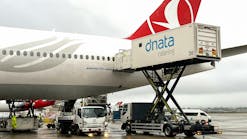Air travel accounts for a relatively small share of worldwide greenhouse gas emissions at just 2%. But that number is growing, and it's growing fast.
In 2018, flying accounted for more than 900 million metric tons of carbon dioxide emitted into the atmosphere. By 2050, some experts predict these emissions will increase two to four times. Some flights, such as from Chicago to Miami, produce more CO2 at once than some people around the world emit in a year.
This year, more than 7.8 million people flew in the week before Christmas. But as many heeded Centers for Disease Control and Prevention advice to avoid traveling, that number is just more than 40% of the number that flew last year.
Even during non-pandemic years, air travel is one of the most carbon-intensive modes of transportation.
Aware of the carbon footprint and environmental stigma of flying, the aircraft industry is taking steps to change. William Crossley, head of the School of Aeronautics and Astronautics at Purdue University, is one of many researchers working on ways to make flying more sustainable.
IND: Why a bump in Thanksgiving travelers at IND might not be repeated over Christmas
Crossley works with a team on ways to improve fuel consumption and introduce new, more efficient airplanes into airline fleets. They run models representing future aircraft and how airlines might use those to meet demand and lower their carbon footprint.
In recent years, the industry has begin working on planes that are more fuel efficient, lighter or even have electric batteries, Crossley said.
The Scrub Hub: Your questions. Our answers.
Do you have questions about the environment? IndyStar environmental reporters Sarah Bowman and London Gibson want to hear from you. Submit your questions here!
“Clearly the airline industry is thinking about it, and so are the aircraft engine manufacturers," Crossley said. "It's good for everybody because ... fuel prices have gone up over time, so saving fuel has been better for the business case."
'Tricky this year': How to help the planet while gift shopping during the pandemic
The carbon cost of flying has become a more popular topic of late, Crossley said, especially after teen climate activist Greta Thunberg crossed the Atlantic Ocean by boat, to avoid emissions from flight.
But we're not all Greta Thunberg, and a challenge with flying is that for most people, there aren't many alternatives, said Jonathon Day, an associate professor in Purdue's school of hospitality and tourism management.
"One of the challenges with flying is that from a consumers point of view, there's only a couple of things you can do," Day said.
Crossley concurs. It's not realistic to expect people to stop flying in the long term, especially as the form of transportation has brought so much benefit, he said, recalling a particularly memorable family trip to Italy that would not have been possible without an airplane.
“There's huge benefits you get from air transportation, right?" Crossley said. "There's a benefit I can't really put a monetary value on ... That's what aerospace engineers do, we make the world smaller."
Deciding when and how to fly
That said, there are a couple of actions you can take. Here's what Day and Crossley suggest:
Ask whether you really need to fly. If it's a moderate trip — say, 1,000 miles or fewer — consider driving instead, especially if you're traveling with a family.
If you're traveling alone and need to go more than 1,000 miles, then it may make more sense to take one nonstop flight.
For example, a round-trip flight to a city 1,000 miles away, such as from Chicago to Denver, emits about 0.3 tons per passenger or 1.19 tons of carbon dioxide total for a family of four, according to the International Civil Aviation Organization.
That same trip by car, on the other hand, would on average amount to 1.4 tons of CO2 emitted, according to myclimate.org. Per person for a family of four, that would be closer to 0.35 tons of CO2 emitted.
Shorter trips, such as from New York to Charlotte, would emit fewer tons of CO2 per person and be better traveled by car.
Fly nonstop when you can. Although it's not always possible and can cost extra, flying nonstop flights could lessen your trip's carbon footprint. The plane emits more emissions during takeoff and landing than it does while coasting, Crossley said, so a trip with fewer connections conserves fuel.
Pack light. The weight of the plane can affect how much fuel it uses — and how many emissions it gives off.
Consider carbon offsets. If you choose to fly, you can buy carbon offsets that fund tree planting, renewable energy or other actions that absorb CO2. Some carbon offsets cost as little as $5 to $10.
Take your good behaviors with you. If you consciously avoid plastic water bottles at home, do it while you're traveling as well. "Even though you're in the holidays," Day said, "You can still do good environmental activities that you would do at home."
Contact IndyStar reporter London Gibson at 317-419-1912 or [email protected]. Follow her on Twitter @londongibson.
Connect with IndyStar’s environmental reporters: Join The Scrub on Facebook.
IndyStar's environmental reporting project is made possible through the generous support of the nonprofit Nina Mason Pulliam Charitable Trust.
This article originally appeared on Indianapolis Star: If you choose to fly, here's how you can do it in a greener way
___
(c)2020 The Indianapolis Star
Visit The Indianapolis Star at www.IndyStar.com
Distributed by Tribune Content Agency, LLC.



